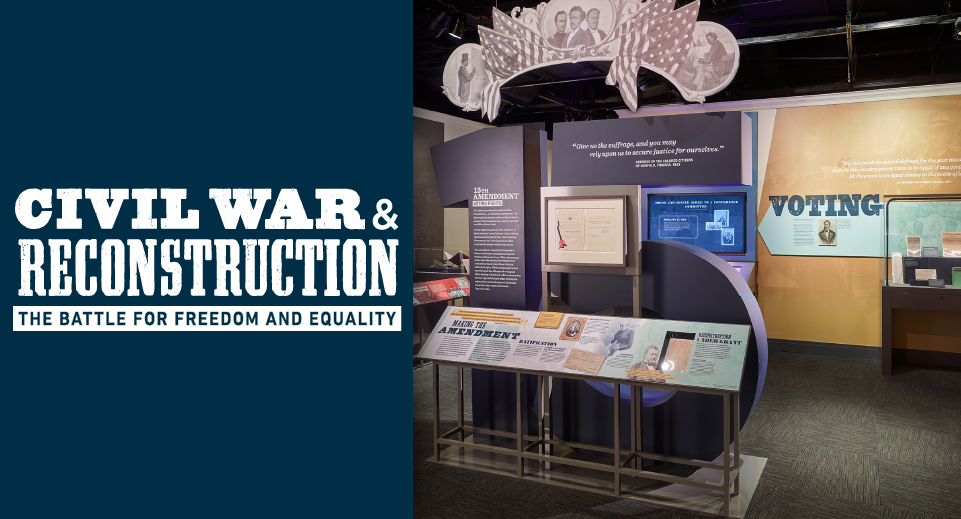Civil War and Reconstruction: The Battle for Freedom and Equality Press Kit

Civil War and Reconstruction: The Battle for Freedom and Equality
May 9, 2019
Civil War and Reconstruction: The Battle for Freedom and Equality
The National Constitution Center’s new permanent exhibit, Civil War and Reconstruction: The Battle for Freedom and Equality, is the first in America devoted to exploring how constitutional clashes over slavery set the stage for the Civil War, and how the nation transformed the Constitution after the war to more fully embrace the Declaration of Independence’s promise of liberty and equality. Through remarkable artifacts and rare documents from one of the largest private Civil War collections in America—the Civil War Museum of Philadelphia—and other partners, the 3,000 square foot exhibit brings to life the stories of Frederick Douglass, Abraham Lincoln, Harriet Tubman, and other figures central to the conflict over slavery. The exhibit also features the inspiring stories of lesser known individuals to help shed light on the American experience under slavery, the battle for freedom during the Civil War, and the fight for equality during Reconstruction, which many call the nation’s “Second Founding.” In doing so, visitors will learn the history of three constitutional amendments added between 1865 and 1870, which ended slavery, required states to respect individual rights, promised equal protection to all people, and expanded the right to vote to African-American men.
Interactive Content
Officeholders By The Numbers
Discover the stories of African American men who held political office during Reconstruction.
MoreIn Their Own Words
Listen to recollections of slavery and freedom from formerly enslaved individuals.
MoreThe Drafting Table
Learn about how the drafting of the 14th Amendment's provisions changed over time.
MorePRESS KIT
Press Releases
- Civil War and Reconstruction Exhibit to Open at the National Constitution Center
- Civil War and Reconstruction Exhibit to Have Permanent Home at National Constitution Center, Beginning May 9, 2019
- On the 150th Anniversary of the 14th Amendment, the National Constitution Center Announces New Exhibit, Theater Performance, and Podcast Series
- The Pew Charitable Trusts Awards $500,000 to National Constitution Center for New Permanent Exhibit on the Constitutional Legacy of the Civil War and the Reconstruction Era Amendments
Full List of Exhibit Artifacts
Onsite Educational Programming
Opening Program: A Conversation with Henry Louis Gates, Jr.
Featured below are exhibit and artifact images, and appropriate credits. Contact Merissa Blum at [email protected] or 215-409-6645 with questions or for additional information.
Courtesy of the National Constitution Center by Peter Van Beever.
View & SaveCourtesy of the National Constitution Center by Peter Van Beever.
View & SaveCourtesy of the National Constitution Center by Peter Van Beever.
View & SaveCourtesy of the National Constitution Center by Peter Van Beever.
View & SaveCourtesy of the National Constitution Center by Peter Van Beever.
View & SaveCourtesy of the National Constitution Center by Peter Van Beever.
View & SaveCourtesy of the National Constitution Center by Peter Van Beever.
View & SaveCourtesy of the National Constitution Center by Peter Van Beever.
View & SaveCourtesy of the National Constitution Center by Peter Van Beever.
View & SaveCommemorative copy of the Emancipation Proclamation, signed by Lincoln, 1864
On loan from The Galbraith Family 2012 Trust
View & Save“Colored” ballot box from Virginia’s first election that permitted African-American voters, 1867
Courtesy of the Library of Virginia
View & SaveIllustrated letter from a Civil War soldier complaining of the heavy loads they are required to carry, 1863
Courtesy of The Civil War Museum of Philadelphia and The Abraham Lincoln Foundation of The Union League of Philadelphia
View & SaveMajor General John Reynolds’s sash that he was wearing when he was killed at Gettysburg
Collection of the Civil War Museum of Philadelphia on loan from Gettysburg Foundation
View & SaveFragment of the flag that Lincoln raised at Independence Hall, 1861
From the Collection of the Civil War Museum of Philadelphia on loan from Gettysburg Foundation
View & SavePortrait of Abraham Lincoln by David Bustill Bowser, an African-American artist, ca. 1864-68
From the Collection of the Civil War Museum of Philadelphia on loan from Gettysburg Foundation
View & Save






